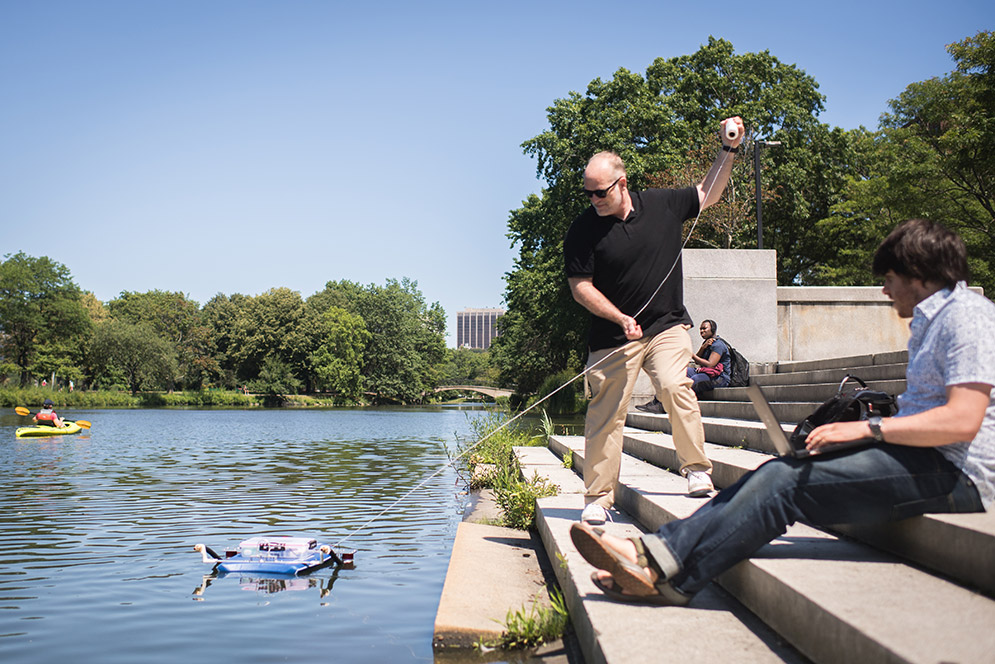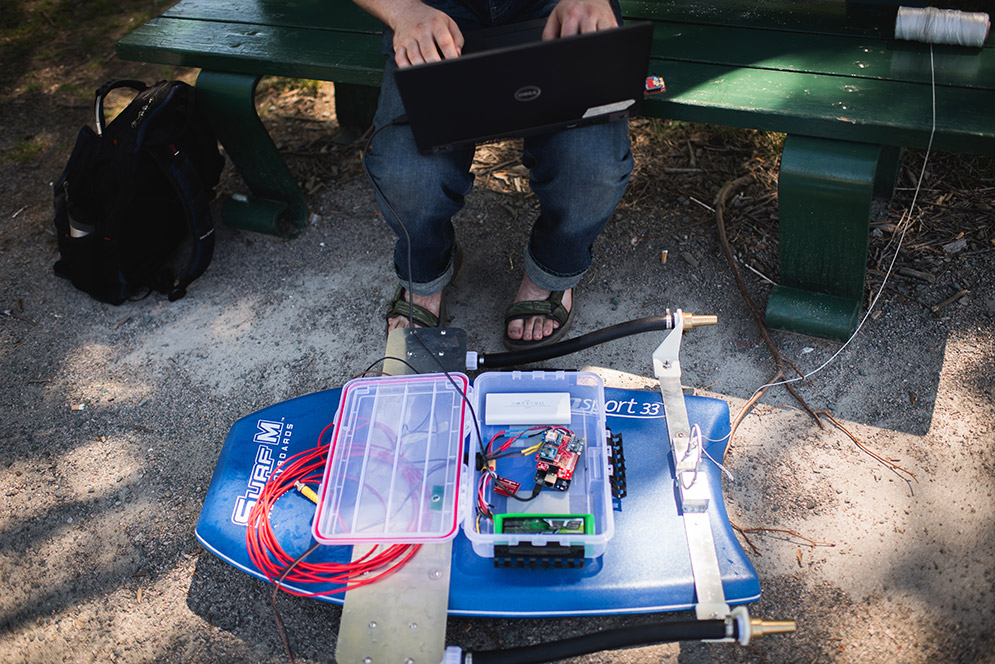Robot Boats and Drug Subs
ENG prof and students developing autonomous boats to find drug traffickers
09.28.2017 By David Levin. Video by Devin Hahn Originally published in BU Today
In 2016, US antidrug agents intercepted a strange vessel off the California coast: a homemade fiberglass submarine. Inside, the small craft was packed to the brim with 12,800 pounds of cocaine, a cargo worth more than $193 million. Since the early 1990s, at least 60 of these narco-subs have been captured. They’re sophisticated contraptions, with multiple crew members and GPS navigation—and their sole purpose is to sneak massive amounts of cocaine, heroin, and other illegal drugs into the country. They’re exceptionally good at their job.
“There may be hundreds more of these subs out there, but, statistically, only a few of them will be caught,” says Greg McDaniel, a College of Engineering associate professor of mechanical engineering and materials science & engineering. “They’re very difficult to detect.”

Greg McDaniel (left) pulls an autonomous robotic drone out of the Charles River lagoon as Noah Bernays (ENG’18) records data on his laptop. Photo by Jackie Ricciardi
McDaniel is trying to improve those odds. With $355,000 in grant funding from the US Naval Sea Systems Command, he and a team of graduate and undergraduate researchers are developing new seafaring robots that can patrol large areas together and collaboratively hunt for underwater threats.
Right now, he says, US agents’ primary means of detecting narco-subs is through towed sonar arrays, which are essentially long cables covered with underwater microphones and dragged behind a ship. These do a decent job of listening for possible targets, but can be used only in relatively deep water and can detect sound only within a limited range. In some cases, it’s also possible to use sophisticated underwater robots called Bluefins to listen for targets, but even these complex machines have their limitations. While they’re much nimbler than a surface ship, they can detect targets only within a few miles and can’t easily communicate their discoveries to human operators while submerged.
Instead of towed cables or underwater robots, McDaniel is building a swarm of pint-sized surface-dwelling drones. These machines would travel around an area of open ocean independently, listening for suspicious sounds. If an individual drone hears a noise, it can alert its robotic colleagues and invite them to collectively hone in on a target. This could help detect narco-subs and other small underwater threats more reliably—making the concept particularly attractive to the US Navy.
“The ocean is dominated by noise that varies strongly with location, depth, frequency, and time,” says Elizabeth Magliula, director of the Naval Engineering Education Consortium at the Naval Undersea Warfare Center in Newport, R.I. “Finding and tracking targets in the presence of this noise may be significantly enhanced by a swarm of collaborating sensors. This research will bring tactical value to emerging and on-the-horizon autonomous vehicles, monitoring stations, and surveillance networks being developed by the navy for undersea distributed network systems.”
Boogie boards and sump pumps
In a windowless lab, McDaniel and Noah Bernays (ENG’18), a mechanical engineering student working on the project, show off their prototypes. They’re surprisingly low-tech, made entirely of off-the-shelf parts: each hull is nothing more than a foam boogie board with a waterproof plastic box strapped on top and a pair of rubber hoses running down its sides. Each robot’s “propulsion system” is a pair of commercial sump pumps, which spray jets of water backward through nozzles borrowed from fire extinguishers. A store-bought hydrophone, an underwater microphone, dangles on a cable underneath. Inside the drone’s electronic control system, which is enclosed in the sealed plastic box, a tiny computer board used for hobby electronics processes sounds and picks out suspicious patterns. In all, each robot costs less than $1,000 to build.
“The philosophy we pushed very early in the process was: don’t reinvent the wheel,” says McDaniel. “There’s a simple way to do it, and there’s a custom way to do it. The challenge is finding the simple way.”
“Because of the off-the-shelf nature of the project, we had to be a little creative about how to hook things up to each other,” adds Bernays. “You have to figure out the right questions to interface two random pieces of hardware or software. But usually, after a few days of tweaking parameters, or swapping some of the hardware, or just changing a line of code, it works.”

Each “boat” is made entirely of off-the-shelf parts, providing an inexpensive test bed for the code McDaniel’s team is developing. Photo by Jackie Ricciardi
The drones’ hardware, McDaniel says, isn’t their selling point. Instead, his team’s real work lies in building and testing the code that controls them, so they can sniff out suspect sounds in the ocean and work together to triangulate their source.
“We’re really exploring ideas coming from the control and signal processing community,” he says. “That’s the real research interest. How do we deal with all the acoustic data coming in? How do we compress it and share it? And then, how do we move each boat independently to get better data that helps them map a region or find and follow a target?”
Swarm intelligence
By sticking with readily available parts, McDaniel says, his team members are able to focus their efforts on creating effective algorithms for navigation and sound detection. Right now, they’re working on software that lets the drones map sounds around them, like large ships or underwater machinery, which could interfere with their ability to hear the much softer whirr of mini subs. Once a drone figures out where these loud sounds are, the team’s algorithm lets it send that information instantly to other drones, so they too can screen out those sounds.
This rapid communication may be key to these robots’ success, says McDaniel. Since the devices themselves remain at the surface, it’s possible for them to send data through the air via Wi-Fi radio signals. Submerged vehicles don’t have that luxury. Radio signals are absorbed quickly by water, so any communication under the surface has to be sent acoustically, like an old telephone modem. The resulting signal is slow and noisy and could drown out the much quieter sound of a fiberglass submarine.
Using Wi-Fi offers another advantage. Since each drone has its own transmitter and receiver, the swarm is able to extend its search range by forming a huge mesh network. Like the router in your living room, each one acts as a hub in that network, passing signals along to its peers. As a result, the robots can spread out over wide areas, yet still remain in contact with every other member of its swarm, regardless of that swarm’s size. McDaniel says this is critical for their ability to collaborate, allowing the swarm to intelligently patrol large swaths of ocean—potentially miles of it—by working together.
“When they’re randomly placed, and one of them hears something, it can say, ‘Hey, I’m over here, come take a look,’ and invite other boats to surround the target. Then together they can try to identify it and tell if it’s something that needs to be followed,” he says.
McDaniel hopes the Navy can use his concepts to design hardware far more advanced than his low-cost boogie boards. With the right algorithm, he says, his team’s work on swarm intelligence and signal processing may one day play a role in launching powerful tools to protect the nation’s coastline, harbors, and ports—not just from illicit drugs, but from more insidious threats as well.
“If you can move six tons of cocaine onto US beaches, you can move six tons of anything, including weapons of mass destruction,” he says. “Ultimately, this work is about protecting people’s lives.”